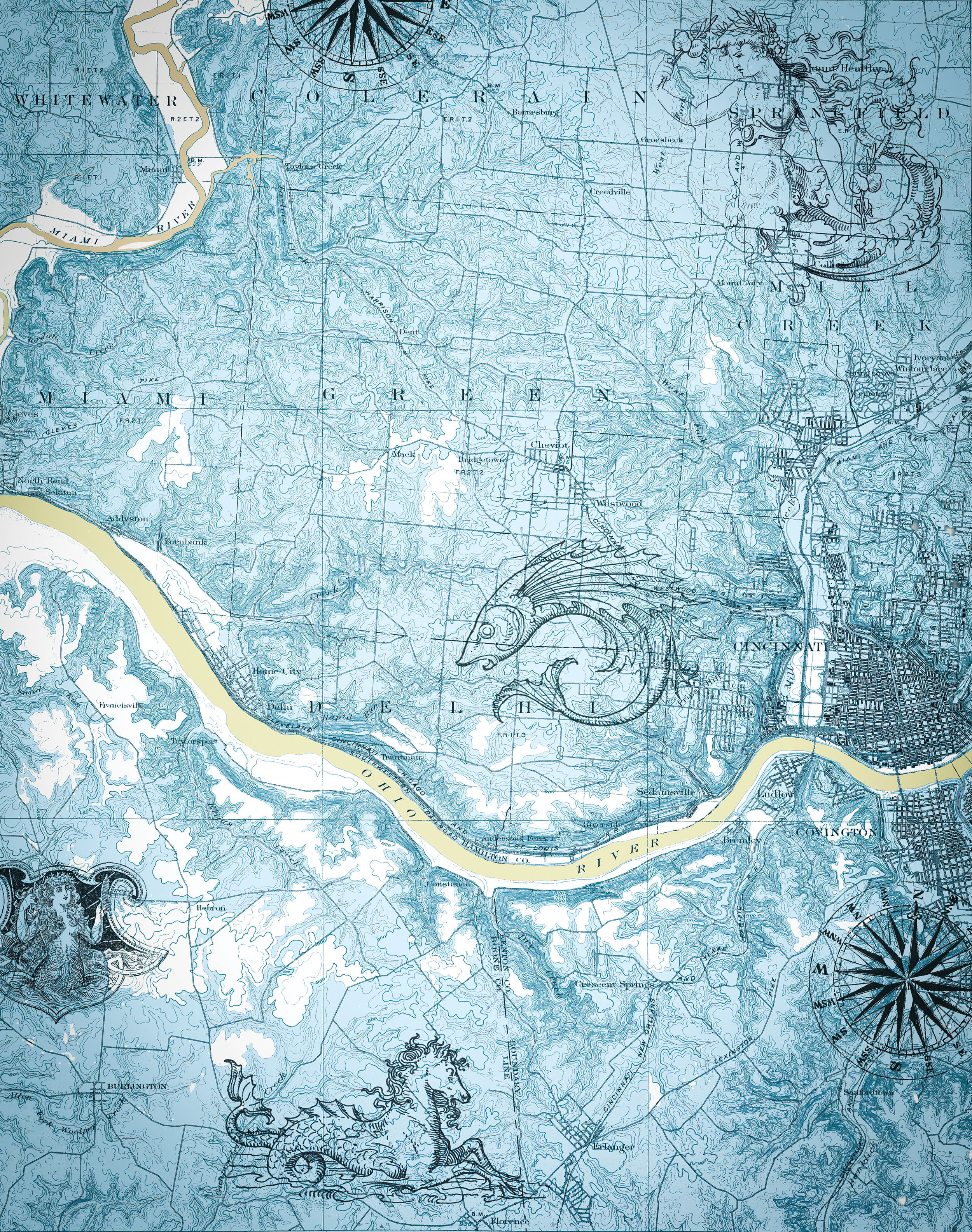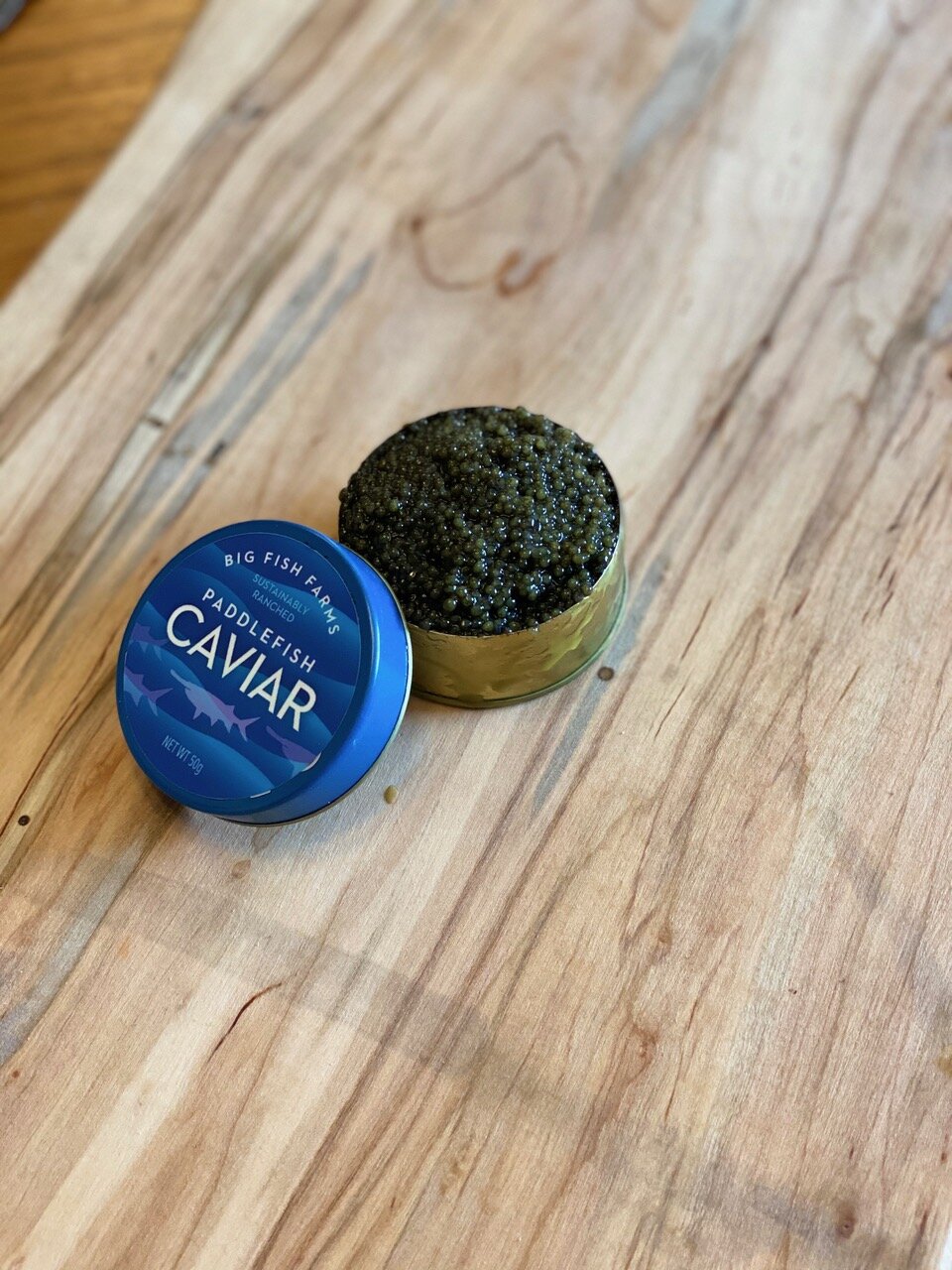Big Fish Farms
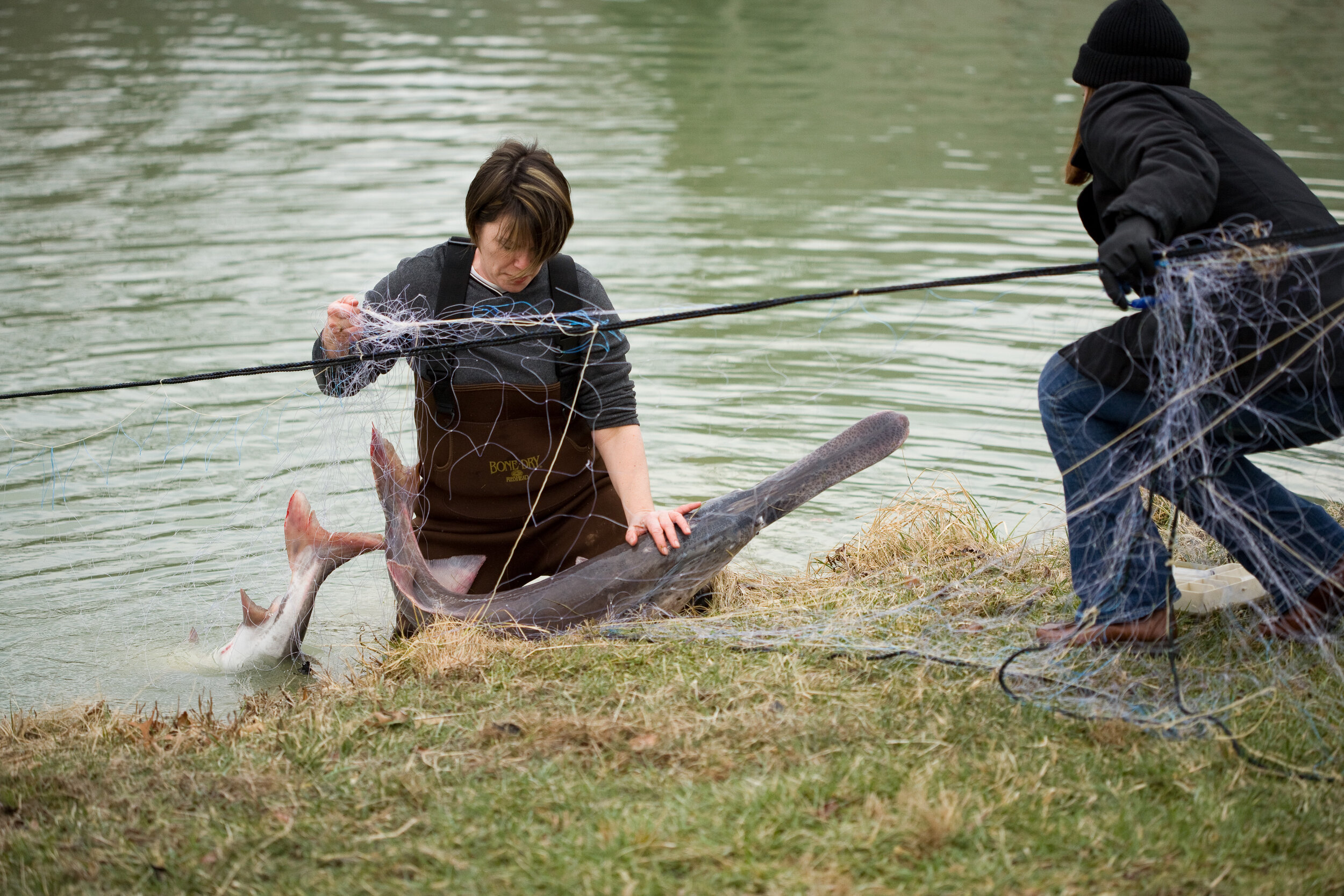
America suffers from a multitude of deficits these days, just a few of which include federal budgets, school test scores, and, some would say, good governance. Second only to our deficit of domestic versus imported oil is our seafood deficit. From canned tuna to Vietnamese shrimp to Norwegian-farmed salmon, America imports vastly more seafood (over 80 percent) than we produce ourselves. But there is one emerging fishery that aims to correct this imbalance, located right here in the Ohio Valley, using all-natural techniques of astonishing sustainability. The fish is the American Paddlefish, the technique is reservoir ranching, and along the way, one finds — in a piece of fishy serendipity — the miracle of some of the best caviar in the world.
The Ikrjanschitza
As curious people are wont to do, Renée Koerner found the paddlefish in oblique fashion. She wasn’t looking for it, per se; really, the prehistoric fish found her. After many years in the restaurant and fine-wine business, Koerner and her husband Keith began looking for a new challenge. They wanted to do something agriculturally based and tied to the land around them, yet they did not have a family farm or lands to draw on. By the by, they found the possibility of paddlefish caviar, as promoted by the Kentucky State University aquaculture program, where researcher Dr. Steve Mims has made a life’s work out of paddlefish and their aquaculture.
“It’s virtually impossible for someone like me, without the inheritance of a family farm, to get into farming in America,” says Koerner, who makes her home in the small burgh of Bellevue, Kentucky, about three blocks from the Ohio River and right across the river from the metropolis of Cincinnati. At first, Renée and Keith hoped merely to make caviar from purchased fish, but they soon realized they would need to control the stocking and farming of the fish. “That’s part of the reason Keith and I got into paddlefish farming,” Renée explains “Reservoir farming is a really smart way to farm. With the usual aquaculture, if you build tanks and ponds and filtering equipment, buying property, it’s so much more expensive than traditional farming; venture capitalists won’t give you money for that sort of thing. We’re so blessed with land and water in this country, why not ranch the paddlefish?” (Which requires none of these investments, more about which is below.)
Starting with very small paddlefish fry, Koerner carefully raises the fish over six months to a size at which they can survive in a pond or reservoir (paddlefish grow relatively quickly, eventually to a size that is larger than any potential predator in their native waters, but in those first six months they would be vulnerable in the open water). She then stocks these fish in privately owned bodies of water, sharing the profits with the landowner when the female fish come to maturity and provide eggs. It costs the landowner nothing; indeed, many of her lake owners choose to get involved simply out of fascination with such a project.
The fish are humanely dispatched, the eggs quickly removed, and immediately the caviar processing begins. The eggs are screened, repeatedly washed in reverse-osmosis-purified water, and personally salted by Renée in a proprietary salting regimen. After about 30 minutes of curing, they are packed into kilo tins and gently pressed to remove additional moisture. The result is immediately quite tasty, but the caviar improves with a month or so of curing.· The thick sides of paddlefish are carefully filleted and set on ice. A pet-food company comes and picks up the carcasses. Nothing is wasted.
All of these techniques were skills hard won on Koerner’s part. The possessors of the knowledge of how to make caviar did not easily give it up. Belying her wine background, Koerner compares it to the time in the 1980s when pioneering California winemaker John Alban went to France’s Rhône Valley to learn about the Viognier grape; the French winemakers were reticent to share their secrets. To become an ikrjanschitza, a caviar maker, Renée had to learn about caviar bit-by-bit, from out-of-print Russian translations and experts who couched mysterious knowledge in obtuse terms. As she practiced her craft, tastings with chefs and foodies confirmed what she suspected: that this caviar was fantastic. But having figured out how to make caviar, the astonishing secrets of the paddlefish spilled out. Renée could no longer merely make the caviar; she had to have the fish as well. And it is a most incredible — even miraculous — fish, enchanting all who encounter it.

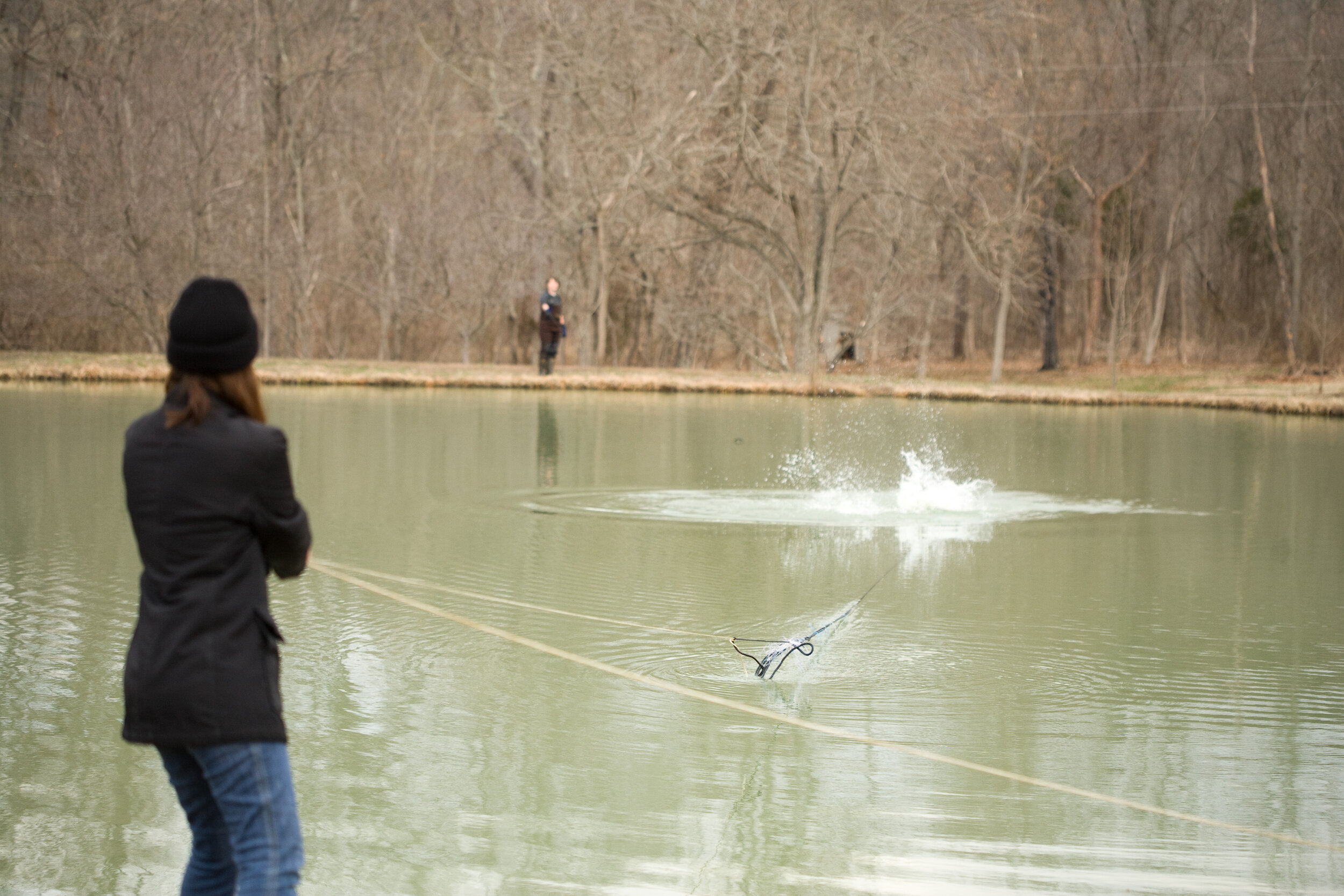
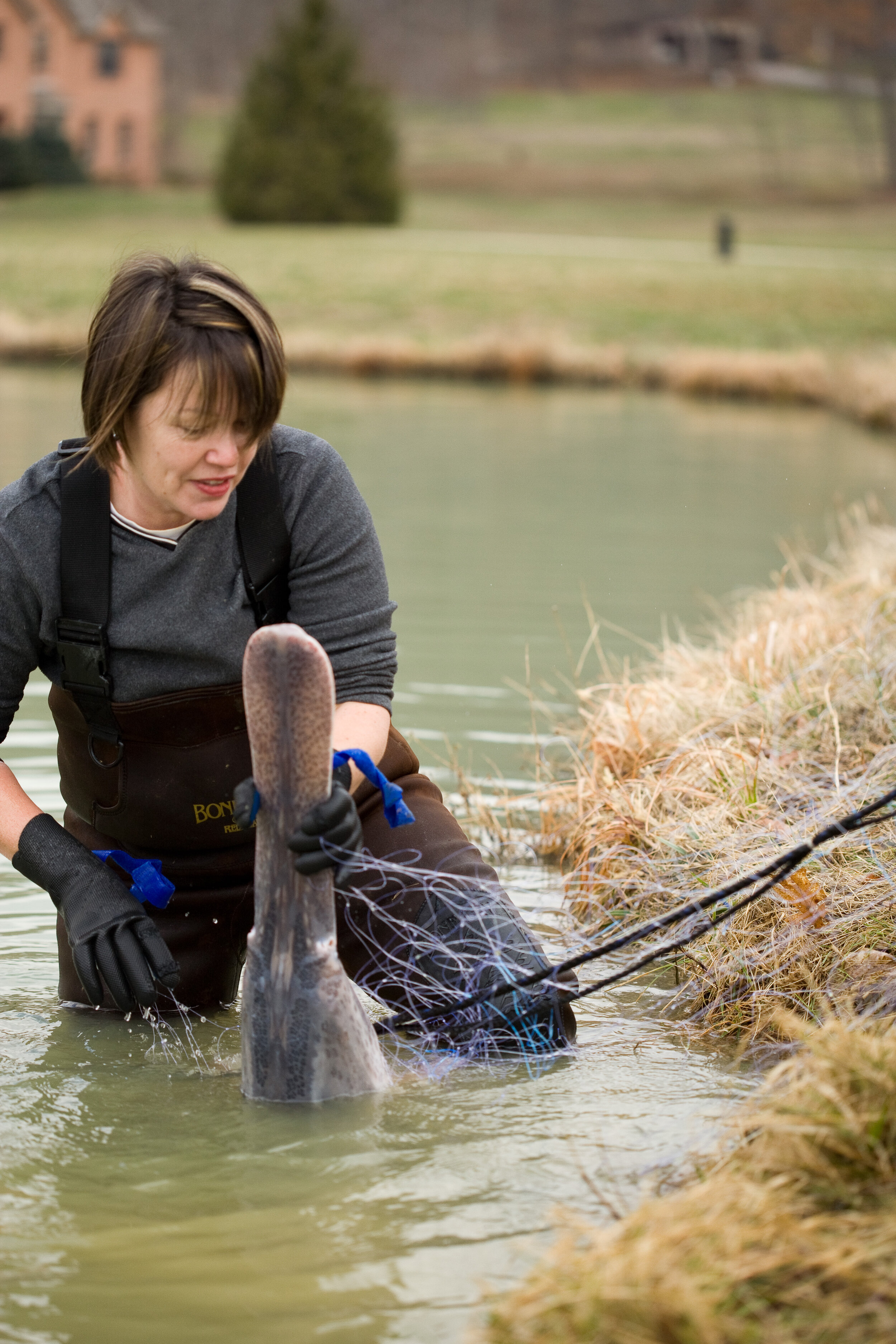
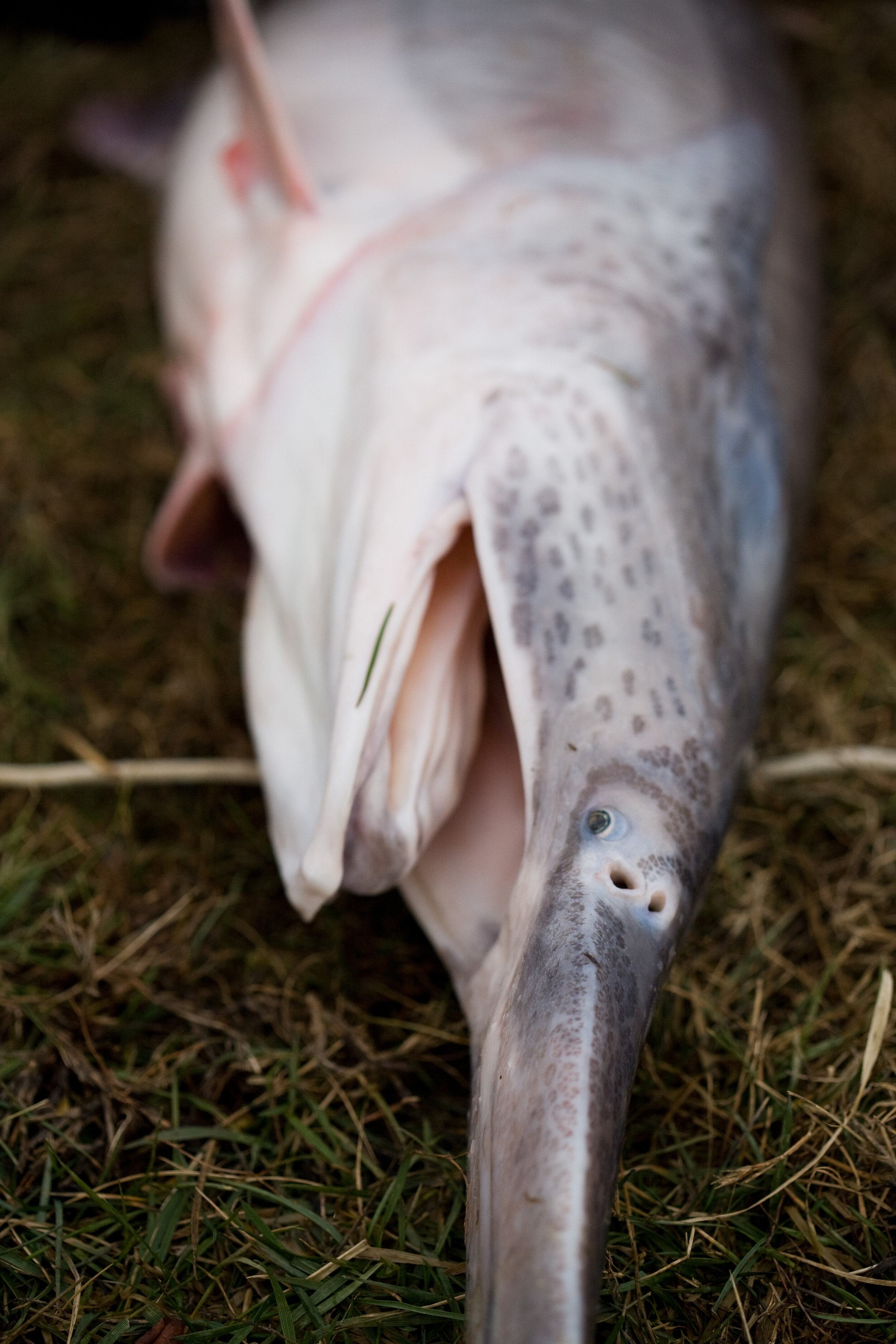
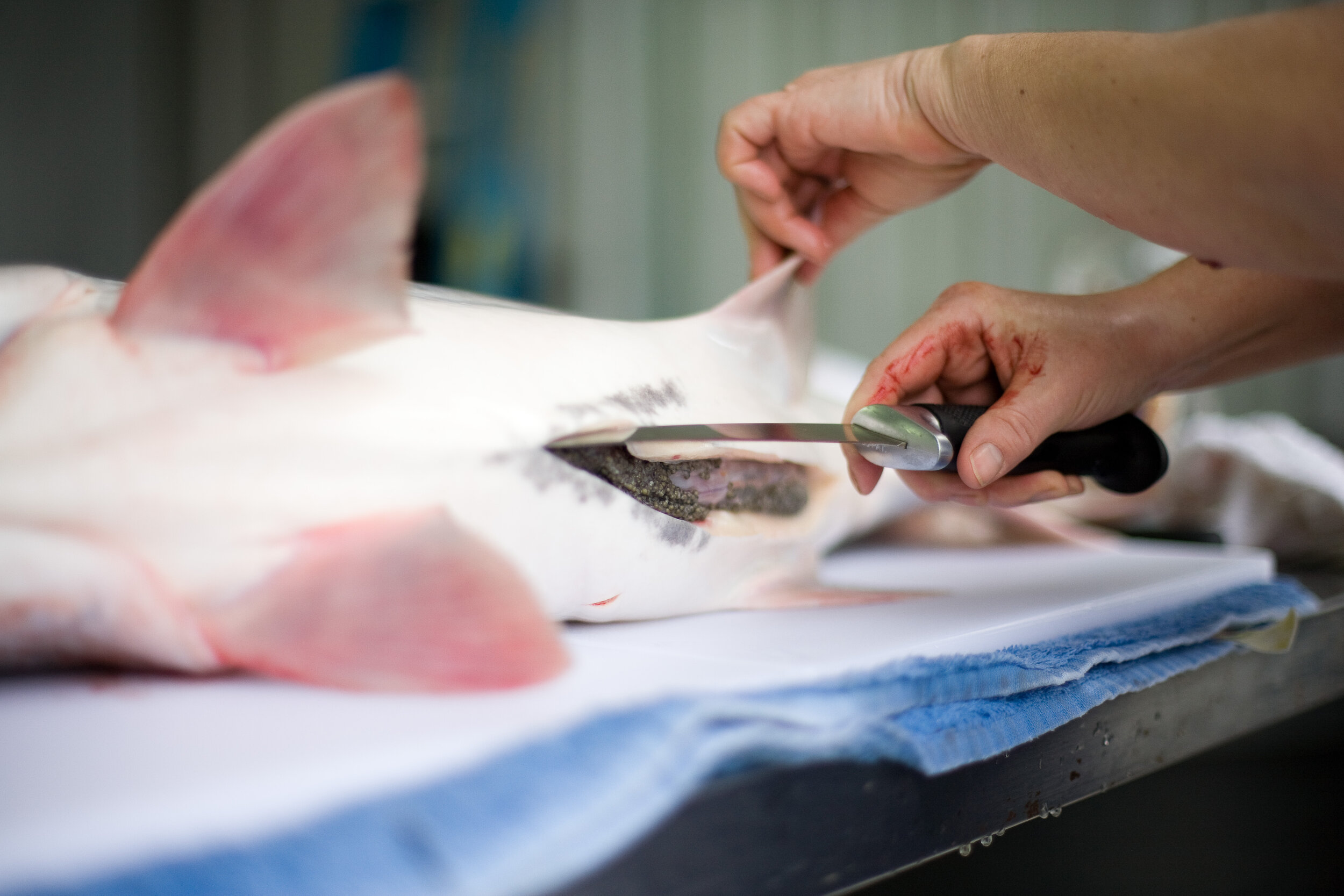
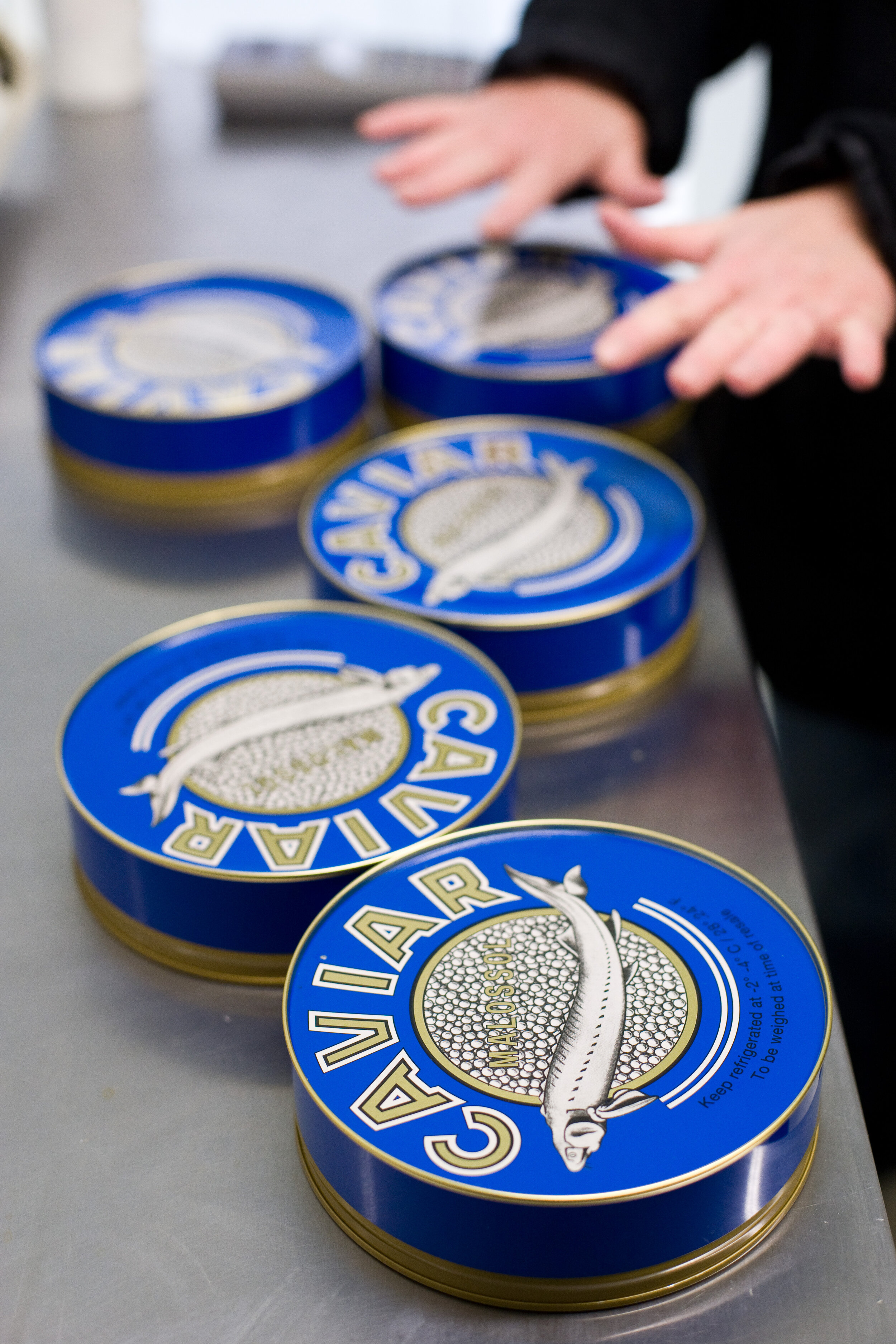
The Perfect Fish
Nearly every fish in the world, as an adult, eats other fish. Very many fish begin their life eating microscopic plankton, and some, such as the farmed and now ubiquitous tilapia, remain vegetarians as adults. But only a few species are plankton feeders as adults, including the two largest fish in the world: the whale shark and the basking shark. Add to this list the paddlefish, of which there are two species in the world: the Chinese Paddlefish, thought to be extinct from the Yangtze River, and the American Paddlefish, which is alive and somewhat well in its native habitat of the Mississippi River drainage system.
The American Paddlefish is found from the headwaters of the Ohio near Pittsburgh to the end of the Missouri River in Montana and in nearly every river in between, though its numbers are much smaller than they used to be. Along with America’s several sturgeon species, these fish are among the largest in North America, up to seven feet long and weighing 150 pounds. They are close relatives of the sturgeon, though with quite a different diet and appearance, and like the sturgeon, they are unchanged in the last 300 million years or so. Paddlefish are capable of covering up to 100 miles in a day, swimming with their mouths agape and collecting their diet of zooplankton, a simple diet with profound ramifications.
While Native Americans greatly enjoyed the native sturgeon — even Henry Longfellow had his Hiawatha going “Forth to catch the sturgeon Nahma/Mishe-Nahma, King of Fishes”— there is little evidence the original inhabitants of this continent had much to do with the paddlefish. Explorer Jonathan Carver in the 1760s mentioned the presence of paddlefish in the Mississippi but noted, “They are not so much esteemed even by the Indians.” But then the Indians never knew the glories of caviar, a delicacy that took the Eurasians many centuries to master and appreciate. Not until the American Caviar Rush from 1870-1900 was it understood that American sturgeon, and the paddlefish, could provide a roe equal in quality to that of the Caspian Sea species.
During this Caviar Rush, the paddlefish began to suffer the same predations of overfishing as its more famous cousin, the sturgeon; both fish are especially vulnerable to overfishing because the very target of caviar production — mature egg-bearing female fish — are exactly the fish that are supposed to reproduce the species. The paddlefish population was heavily fished at various points from 1870 through 1980. Today paddlefish are protected in most of their home range. A few states permit commercial fishing from large rivers — including Kentucky’s commercial fishery in the Ohio River — but in the long term, harvests of paddlefish from the wild merely perpetuate the same dynamic of overfishing and poaching that practically extirpated the East Coast’s sturgeon and decimated the paddlefish a century ago. Some states allow and promote the farming of paddlefish. It is this farming, or ranching, of paddlefish that holds promise, not only commercially but more importantly for the future of the species.
The Perfect Farm
Aquaculture farms around the globe have attained a mixed reputation. On the one hand they offer an apparently easy source of protein, helping to solve economies and (presumably) human hunger around the world. Their critics blast them on many charges, including the many pounds of other fish (or produce) required to produce one pound of fish; the effect of fish farms on water quality; and various other issues. The notion that an aquaculture model could vanquish all these concerns while still delivering quality protein — let alone a product as rare and wonderful as caviar — is a bit of a pipe dream.
Yet that is exactly what can be accomplished with a paddlefish farm. Consider: The paddlefish eat plankton, the microscopic organisms which naturally occur in a body of water. Except for a brief diet of fish-food pellets during the first six months of their life — and this only to ensure the fish grow large enough to survive their first year — one does not feed paddlefish, they simply feed themselves, gathering up zooplankton in the water. A lake on a paddlefish farm requires no sardines, as fed to salmon in vast quantities of fish meal, nor the fattening corn as fed to tilapia. Their feasting on plankton actually improves the quality of the water for other uses. They simply eat plankton, grow and grow to maturity, and eventually provide a superb side of meat or, better yet, a kilo of roe for caviar.
The output of a paddlefish-farming operation is measurable in kilos of caviar and pounds of meat. (And what meat! Paddlefish meat is incredibly dense, almost like a loin of pork, cooking up with terrific juiciness and big, meaty texture. Like sturgeon, it takes to smoking exceptionally well.) But what’s harder to account for is the effect it could have on the sturgeon. A robust paddlefishfarm fishery in America could relieve the Caspian sturgeon of the burden of providing caviar to the tables of the world. That alone would be a glorious outcome, but there are even more benefits beyond the fish eggs. Paddlefish are cartilaginous fish, without the bony structure of a more advanced fish such as, for example, the trout. There exists the possibility that the fins of paddlefish could be developed as a replacement for another species under the gun of overfishing: the shark, whose cartilaginous fins go into the famous sharkfin soup of Chinese culture.
This paddlefish is almost too good to be true: a miracle fish, requiring no particular feeding as adults and almost no care, no filtration of water, or aeration of tanks as in other commercialized farms; it even helps other threatened fish. Astonishingly, the ancient paddlefish neutralizes every single complaint against fish farms. Considering the great amount of land and inland water that is available in the Midwest, a real revolution could be realized in American aquaculture if paddlefish reservoir ranching took hold.
Consider all the ways paddlefish coexist seamlessly with the fish around them. Paddlefish will not take a hook, so they do not interfere with game fishing in, for example, a public reservoir. The large gill nets used to catch paddlefish for harvest do not trap other fish; there is no deadly, accidental “bycatch” that kills unwanted fish. And the paddlefish harvest takes place in late winter, when other species are lying dormant at the bottom of the lake. Paddlefish even provide a sort of immunity regarding the escape of captive farm fish, and their subsequent reproduction in the wild: Paddlefish only spawn and reproduce in running water, not in lakes or ponds, hence they will never overpopulate a body of water in which they are stocked. They don’t eat other fish or compete for the same food supply, so stocking paddlefish does not impact other species. As for the lake itself, paddlefish ranching involves no unsightly caging or fencing in the water — the operation is invisible. And the fish improve the quality of the water rather than causing algal blooms or a chemical discharge.
It’s not as if paddlefish products lack a good market. Caviar is sought in virtually every country around the world, at exactly a time when the supply of Caspian caviar is largely dried up. Chefs have roundly embraced the superb meat of the paddlefish, the remarkable density of which lends it to preparations impossible with, for example, sole or trout. Koerner notes about any new venture, “Usually the hardest part is making the product and finding the market. We already had that. As we learned about the paddlefish, I could see that paradoxically, even though the fish is so perfect, I knew that to really do it right — the farming — would be hard to do.” The main obstacles to paddlefish ranching, says Koerner, are finding the water and dealing with state regulatory bodies. “Aquaculture is regulated by multiple bodies. The states that have pulled ahead have moved aquaculture from natural resources to agriculture. Sometimes I’m told, ‘That’s a great idea, but we can’t be the first ones to do it.’ ”
Regrettably, it may not be American Midwestern states that finally build a clean and profitable paddlefish caviar business. As Koerner notes, with no small amount of umbrage, “China has been buying paddlefish eggs. Really? Is this another one of our great American ideas that has to go overseas to be successful? What happened to American ingenuity? If we can’t implement paddlefish ranching because of bureaucracies it would be really sad — for our agriculture, for the paddlefish, for me personally, of course. Kentucky State University did the work of figuring out how to do this. The idea of not being able to use our own American research really bugs me.” The Chinese government has the advantage of essentially no issues regarding regulation or conservation. If they need big water for aquaculture, they might simply flood a valley.
The World Wants Caviar
Few products of any kind in the world — gold and diamonds come to mind — and even fewer foods have the sort of dramatic historical sweep of caviar, “the last incarnation of the Immortals” as food writer Maguelonne Toussaint-Samat aptly put it. To set upon kilo tins of caviar with reckless abandon is the terminus of luxury, the province of kings and czars and rock stars. But in truth, what has been set upon, with heedless voracity and repeatedly around the world, is the fisheries that provide this fantastic food. As Richard Adams Carey so eloquently described in his sturgeon book The Philosopher Fish, these “lost and extinguished fisheries are graves in our own family plot.” Is it finally time to obtain our caviar rightly, and carefully, with a miracle fish that will save its cousins, clean the water, pay its own way, and not cost the country a thing? The ikrjanschitza beckons. We fish-loving Americans would do well to follow her.
Jay Erisman is a Greater Cincinnati-based wine, spirits, and food professional. He works at The Party Source in Bellevue, Kentucky, and is building a Bourbon distillery in Newport.


